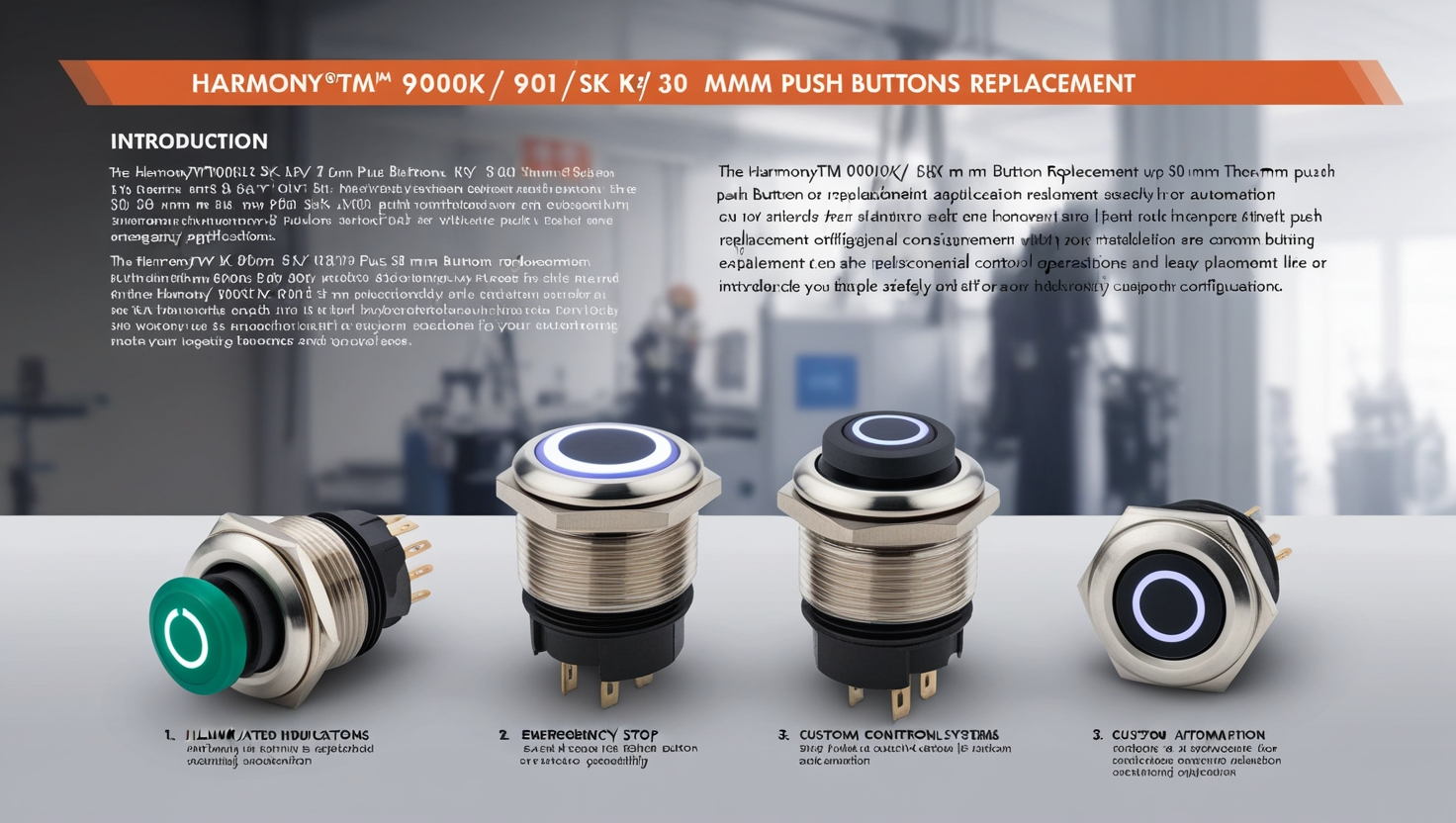Introduction
The HarmonyTM 9001K/SK/KX 30 mm Push Buttons Replacement are renowned for their durability and reliability in industrial control systems. These push buttons are designed to perform seamlessly in harsh environments and are vital in automation and machinery applications. Their versatile design includes illuminated indicators, emergency stop actuators, and custom configurations to suit various operational needs. Whether replacing worn-out buttons or upgrading your control panels, HarmonyTM 9001K/SK/KX 30 mm push buttons deliver consistent performance and enhance safety. They are essential for maintaining efficient system operations with easy installation and a range of customization features.
Understanding HarmonyTM 9001K/SK/KX 30 mm Push Buttons Replacement
The HarmonyTM 9001K/SK/KX 30 mm push buttons replacement process is essential for maintaining the functionality of industrial control systems. Due to their reliability, these push buttons are widely used in machinery and automation. Over time, frequent usage can cause wear and tear, necessitating replacements. Ensuring compatibility with the existing setup is crucial during the replacement. Regular replacements keep systems operating efficiently and safely.
Common Issues Leading to Replacement
Frequent use in demanding environments makes the HarmonyTM 9001K/SK/KX 30 mm push buttons replacement an everyday necessity. Problems like sticking mechanisms, faded indicators, or unresponsive actuators often arise. Environmental factors such as moisture or dust can also contribute to their deterioration. Identifying these issues early ensures timely replacement. Proactive replacements prevent downtime and enhance overall system performance.
Selecting the Right Replacement
Choosing the appropriate component is key when performing a HarmonyTM 9001K/SK/KX 30 mm push buttons replacement. Matching specifications like actuator type, voltage rating, and contact configuration are essential. Replacement buttons must align with the system’s requirements to ensure seamless integration. Using authentic parts from reliable suppliers guarantees quality. Proper selection enhances system reliability and user safety.
Step-by-Step Replacement Guide
When done systematically, performing a HarmonyTM 9001K/SK/KX 30 mm push button replacement is straightforward. For safety, start by turning off the power supply. Remove the old button from the control panel and inspect the wiring. Install the new button, ensuring all connections are secure. Finally, test the button to confirm it functions correctly, minimizing disruptions to operations.
Benefits of Regular Replacement
Regular HarmonyTM 9001K/SK/KX 30 mm push buttons replacement helps maintain consistent system performance. Replacing worn-out buttons improves operational safety and reduces the risk of equipment failure. It also enhances user experience with smooth and responsive controls. Ensuring timely replacements extends the lifespan of the overall system. Emergency repairs are always more expensive than preventative maintenance.
Customization Options for Replacements
A HarmonyTM 9001K/SK/KX 30 mm push buttons replacement offers opportunities for customization. Buttons can be replaced with models featuring different colors, illuminated options, or unique markings. These features improve visibility and usability in various environments. Customization also allows operators to adapt controls to specific tasks. Tailoring replacements ensures optimal system functionality.
Tools Required for Replacement
A HarmonyTM 9001K/SK/KX 30 mm push button replacement requires essential tools such as screwdrivers, pliers, and wire strippers. Additional tools like a multimeter can be used to check electrical connections. Having the right tools on hand ensures a smooth replacement process. Proper preparation minimizes the risk of errors or damage during installation.
Importance of Authentic Parts
Replacing genuine components for HarmonyTM 9001K/SK/KX 30 mm push button replacement is critical for maintaining system integrity. Authentic parts are designed to meet the same standards as the original buttons. Counterfeit or low-quality replacements may fail prematurely or cause malfunctions. Purchasing from authorized dealers ensures long-lasting performance. Trustworthy parts are essential for industrial reliability.
Troubleshooting After Replacement
After completing a HarmonyTM 9001K/SK/KX 30 mm push buttons replacement, it’s important to test the system thoroughly. Check for issues like loose connections, improper mounting, or unresponsive controls. Identifying and addressing problems early prevents future malfunctions. Regular testing post-replacement ensures the button operates as intended. Effective troubleshooting enhances overall system performance.
Environmental Considerations During Replacement
The HarmonyTM 9001K/SK/KX 30 mm push buttons replacement process should account for environmental factors. Buttons in harsh settings may require higher dust, moisture, or vibration resistance. Selecting replacements with the appropriate ecological ratings ensures longevity. Additionally, proper disposal of old buttons promotes sustainability. Considering these factors enhances system durability and eco-friendliness.
Conclusion
The HarmonyTM 9001K/SK/KX 30 mm push button replacement process is essential for maintaining industrial control systems’ efficiency, safety, and longevity. Operators can ensure reliable performance even in challenging environments by choosing compatible and authentic components. Regular inspection and timely replacements prevent unexpected downtime and enhance system productivity. Whether upgrading to newer models or replacing worn-out buttons, careful attention to detail ensures seamless integration and functionality. Prioritizing quality and proper installation in replacements guarantees the continued success of your operational systems.

